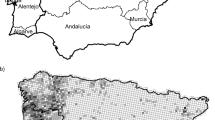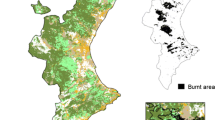Abstract
Not all wildfire ignitions result in burned areas of a similar size. The aim of this study was to explore whether there was a size-dependent pattern (in terms of resulting burned area) of fire ignitions in Portugal. For that purpose we characterised 71,618 fire ignitions occurring in the country in the period 2001–2003, in terms of population density in the local parish, land cover type and distance to roads. We then assigned each ignition into subsets of five classes according to the resulting burned area: >5 ha, >50 ha, >100 ha, >250 ha, >500 ha. The probability of an ignition resulting in different burned area classes was modelled using binary logistic regression, and the relative importance, strength and signal (positive or negative) of the three explanatory variables compared across the models obtained for the different classes. Finally, we explored the implications of land cover and population density changes during the period 1990–2000 in Portugal for the likelihood of ignitions resulting in wildfires >500 ha. Population density was the more important variable explaining the resulting burned area, with the probability of an ignition resulting in a large burned area being inversely related to population density. In terms of land cover, ignitions resulting in large burned areas were more likely to occur in shrubland and forest areas. Finally, ignitions farther away from roads were more likely to result in large burns. The current land cover trends (decrease of agricultural land and increase in shrublands) and population trends (decline in population densities except near the coast) are increasing the probability that ignitions will result in large fires in vast regions of the country.





Similar content being viewed by others
References
Bermudez Z, Mendes J, Pereira JMC, Turkman KF, Vasconcelos MJP (2009) Spatial and temporal extremes of wildfire sizes in Portugal. Int J Wildland Fire 18:983–991
Bonazountas M, Kallidromitou D, Kassomenos PA, Passas N (2005) Forest fire risk analysis. Hum Ecol Risk Assess 11:617–626
Cardille JA, Ventura SJ (2001) Occurrence of wildfire in the northern Great Lakes Region: effects of land cover and land ownership assessed at multiple scales. Int J Wildland Fire 10:145–154
Cardille JA, Ventura SJ, Turner MG (2001) Environmental and social factors influencing wildfires in the Upper Midwest, USA. Ecol Appl 11:111–127
Catry FX, Damasceno P, Silva JS, Galante M, Moreira F (2007) Spatial distribution patterns of wildfire ignitions in Portugal. In: Proceedings of the 4th international wildland fire conference, Seville. CD Rom
Catry FX, Rego F, Moreira F, Bação F (2008) Characterizing and modelling the spatial patterns of wildfire ignitions in Portugal: fire initiation and resulting burned area. In: de las Heras J, Brebbia C, Viegas D, Leone V (eds) WIT transactions on ecology and the environment, vol 119. WIT Press, Toledo, Spain, pp 213–221
Catry FX, Rego F, Bação F, Moreira F (2009) Modelling and mapping wildfire ignition risk in Portugal. Int J Wildland Fire 18:921–931
Chou YH (1992) Management of wildfires with a geographical information system. Int J Geogr Inf Syst 6:123–140
Chuvieco E, Salas J, Barredo JI, Carvacho L, Karteris M, Koutsias N (1998) Global patterns of large fire occurrence in the European Mediterranean Basin: a GIS analysis. In: Viegas DX (ed) Proceedings of the 3rd international conference on forest fire research—14th conference on forest fire meteorology, vol II. ADAI, University of Coimbra, Portugal, pp 2447–2462
Chuvieco E, Allgöwer B, Salas J (2003) Integration of physical and human factors in fire danger assessment. In: Chuvieco E (ed) Wildland fire danger estimation and mapping. The role of remote sensing data, vol 4. World Scientific Publishing, Singapore
Debussche M, Lepart J, Dervieux A (1999) Mediterranean landscape changes: evidence from old postcards. Glob Ecol Biogeogr 8:3–15
DGF (2001) Inventário florestal nacional. Portugal continental. 3ª Revisão, 1995–1998. Direcção-Geral das Florestas, Lisboa
DGF (2003) Determinação das causas dos incêndios florestais em 2002. Direcção-Geral das Florestas, Lisboa
DGRF (2006) Incêndios florestais – Relatório de 2005. Divisão de Defesa da Floresta Contra Incêndios. Direcção-Geral dos Recursos Florestais (Lisboa)
EC (2008) Forest fires in Europe 2007. Report 8. European Commission, Joint Research Centre, Institute for Environment and Sustainability, Ispra, Italy, 80 pp
ESRI (2005) ArcGIS 9.1. software. Environmental Systems Research Institute, Redlands, CA
FAO (1986) Wildland fire management terminology. FAO Forestry Paper 70, Food and Agriculture Organization of the United Nations, 257 pp
Ferrão J (2004) Dinâmicas territoriais e trajectórias de desenvolvimento: Portugal 1991–2001. Revista de Estudos Demográficos 34:17–25
Finney MA (2005) The challenge of quantitative risk analysis for wildland fire. For Ecol Manage 211:97–108
Genton MG, Butry DT, Gumpertz ML, Prestemon JP (2006) Spatio-temporal analysis of wildfire ignitions in the St Johns River Water Management District, Florida. Int J Wildland Fire 15:87–97
Hill J, Stellmes M, Udelhoven T, Röder A, Sommer S (2008) Mediterranean desertification and land degradation: mapping related land use change syndromes based on satellite observations. Glob Planet Change 64:146–157
Hosmer DW, Lemeshow S (1989) Applied logistic regression. Wiley, New York
IA (2003) Atlas do Ambiente Digital. Instituto do Ambiente. Available at www.iambiente.pt/atlas/est/index.jsp [Verified 2 March 2007]
IA (2005) CORINE Land Cover 2000 Portugal. Instituto do Ambiente
IGEOE (2005) Carta Militar Itinerária de Portugal. Instituto Geográfico do Exército. Available at www.igeoe.pt [Verified 2 March 2007]
IGP (2004) Carta administrativa oficial de Portugal. Instituto Geográfico Português. Available at www.igeo.pt/igeo/portugues/Frameset-egeo.htm [Verified 2 March 2007]
INE (1996) Censos 1991. Resultados definitivos. Instituto Nacional de Estatística
INE (2003) Dados estatísticos da população em Portugal - Censos 2001. Instituto Nacional de Estatística
Johnson EA, Miyanishi K (2001) Forest fires: behavior and ecological effects. Academic Press, San Diego, CA
Kilinc M, Beringer J (2007) The spatial and temporal distribution of lightning strikes and their relationship. J Clim 20:1161–1173
Loboda TV, Csiszar IA (2007) Assessing the risk of ignition in the Russian Far East within a modelling framework of fire threat. Ecol Appl 17:791–805
MacDonald D, Crabtree JR, Wiesinger G, Dax T, Stamou N, Fleury P, Gutierrez Lazpita J, Gibon A (2000) Agricultural abandonment in mountain areas of Europe: environmental consequences and policy response. J Environ Manage 59:47–69
Mercer DE, Prestemon JP (2005) Comparing production function models for wildfire risk analysis in the wildland-urban interface. For Pol Econ 7:782–795
Mermoz M, Kitzberger T, Veblen TT (2005) Landscape influences on occurrence and spread of wildfires in Patagonian forests and shrublands. Ecology 86:2705–2715
MMA (2007) Los incendios forestales en España. Decenio 1996–2005. Area de Defensa Contra Incendios Forestales. Ministerio de Medio Ambiente, Madrid
Moreira F, Russo D (2007) Modelling the impact of agricultural abandonment and wildfires on vertebrate diversity in Mediterranean Europe. Landscape Ecol 22:1461–1476
Moreira F, Rego F, Ferreira P (2001) Temporal (1958–1995) pattern of change in a cultural landscape of northwestern Portugal: implications for fire occurrence. Landscape Ecol 16:557–567
Moreira F, Vaz P, Catry F, Silva JS (2009) Regional variations in wildfire preference for land cover types in Portugal: implications for landscape management to minimise fire hazard. Int J Wildland Fire 18:563–574
Moreno JM, Vázquez A, Vélez R (1998) Recent history of forest fires in Spain. In: Moreno JM (ed) Large forest fires. Backhuys, Leiden, pp 159–185
Mouillot F, Ratte J, Joffre R, Mouillot D, Rambal S (2005) Long-term forest dynamic after land abandonment in a fire prone Mediterranean landscape (central Corsica, France). Landscape Ecol 20:101–112
Nunes A, Duarte J (2006) Assessment of forest fire risk in the Serra da Estrela Natural Park (Portugal): methodological application and validation. In: Proceedings of the 5th international conference on forest fire research, Figueira da Foz. CD Rom
NWCG (2006) Glossary of wildland fire terminology. PMS 205, National Wildfire Coordinating Group
Pearce J, Ferrier S (2000) Evaluating the predictive performance of habitat models developed using logistic regression. Ecol Model 133:225–245
Pérez B, Cruz A, Fernández-González F, Moreno JM (2003) Effects of the recent land-use history on the postfire vegetation of uplands in Central Spain. For Ecol Manage 182:273–283
Pinto-Correia T, Breman B, Jorge V, Dneboská M (2006) Estudo sobre o abandono em Portugal continental. Análise das dinâmicas da ocupação do solo, do sector agrícola, e da comunidade rural.Tipologia de áreas rurais. Universidade de Évora, 226 pp
Preisler HK, Brillinger DR, Burgan RE, Benoir JW (2004) Probability based models for estimation of wildfire risk. Int J Wildland Fire 13:133–142
Rego FC, Catry FX, Maia MJ, Santos TA, Gravato A, Castro IC, Moreira FO, Pinto PR, Almeida J (2004) Análise da Rede Nacional de Postos de Vigia em Portugal. Technical Report, Lisboa
Roloff GJ, Mealey SP, Clay C, Barry J, Yanish C, Neuenschwander L (2005) A process for modelling short and long-term risk in the southern Oregon Cascades. For Ecol Manage 211:166–190
Romero-Calcerrada R, Novillo CJ, Millington JDA, Gomez-Jimenez I (2008) GIS analysis of spatial patterns of human-caused wildfire ignition risk in the SW of Madrid (Central Spain). Landscape Ecol 23:341–354
Rothermel R (1983) How to predict the spread and intensity of forest and range fires. General Technical Report INT-143, Forest Service, United States Department of Agriculture, 161 pp
Santos FD, Miranda P (2006) Alterações climáticas em Portugal: Cenários, Impactos e Medidas de adaptação Project SIAM II. Gradiva, Lisbon
Saveland JM, Neueschwander LF (1990) A signal detection framework to evaluate models of tree mortality following fire damage. For Sci 36:66–76
SPSS (2006) SPSS for Windows. SPSS Inc., Chicago
Van Doorn A, Bakker M (2007) The destination of arable land in a marginal agricultural landscape in South Portugal: an exploration of land use change determinants. Landscape Ecol 22:1073–1087
Vasconcelos MJP, Silva S, Tomé M, Alvim M, Pereira JMC (2001) Spatial prediction of fire ignition probabilities: comparing logistic regression and neural networks. Photogramm Eng Remote Sens 67:73–81
Vasilakos C, Kalabokidis K, Hatzopoulos J, Kallos G, Matsinos Y (2007) Integrating new methods and tools in fire danger rating. Int J Wildland Fire 16:306–316
Vazquez A, Moreno JM (1998) Patterns of lightning- and human-caused fires in peninsular Spain. Int J Wildland Fire 8:103–115
Vega-Garcia C, Lee BS, Woodard PM, Titus SJ (1996) Applying Neural Network technology to human-caused wildfire occurrence prediction. Art Int Appl 10:9–18
Yang J, Healy HS, Shifley SR, Gustafson EJ (2007) Spatial patterns of modern period human-caused fire occurrence in the Missouri Ozark Highlands. For Sci 53:1–15
Acknowledgements
We acknowledge the Portuguese Forest Services (DGRF) for all collaboration and for providing the wildfire database. We also thank Paula Lopes, António Nunes and Vasco Nunes for their help on preliminary data processing. This study was supported by the European Commission under the 6th Framework Programme through the Integrated Project “Fire Paradox” (contract no. FP6-018505), by IFAP-IP through the Project “Recuperação de áreas Ardidas”, and by Project FIRELAND (Project PTDC/AGR-CFL/104651/2008). FC was funded by Fundação para a Ciência e a Tecnologia (PhD grant SFRH/BD/65991/2009).
Author information
Authors and Affiliations
Corresponding author
Rights and permissions
About this article
Cite this article
Moreira, F., Catry, F.X., Rego, F. et al. Size-dependent pattern of wildfire ignitions in Portugal: when do ignitions turn into big fires?. Landscape Ecol 25, 1405–1417 (2010). https://doi.org/10.1007/s10980-010-9491-0
Received:
Accepted:
Published:
Issue Date:
DOI: https://doi.org/10.1007/s10980-010-9491-0




